It is 8:00 PM, on Saturday, September 7, 2012. Last night San Francisco Opera opened its 89th season with Verdi’s Rigoletto. However, tonight will be “opening night” for the three principal members of the cast -Albina Shagimuratova (Gilda), Marco Vratogna (Rigoletto), and Francesco Demuro (The Duke of Mantua), since the company is splitting the 12 September performances between two casts.
The house lights dim – the house grows still – a growing sea of applause begins, indicating that Maestro Nicola Luisotti is wending his way through the orchestra, and reaches a climax when he mounts the podium and we can all see him – the customary handshakes to the principals and bows to the audience – instant silence as he faces the audience and raises his arms –
The menacing overture begins. With the first crashing chord the curtain rises to show a dimly lighted arcade with several openings and a figure seated on the floor.
Another crashing chord and suddenly the side hallways are all flooded with an intense red light – bordello red.
The chord is repeated a third time and there is instantaneous white light illuminating the scene and spotlighting the seated figure of the jester.
Kudos to Set Designer Michael Yeargan and Lighting Designer Christopher Maravich for giving us such vivid sets and dramatic lighting, both serving only to enhance the music and action – not to distract from them. Yeargan admits that he got his inspiration for the sets from the paintings of Giorgio de Chirico (1888-1978). In a fascinating one-page article in the opera program he writes:
De Chirico’s paintings have a surreal quality that suggests a world of impending doom – that unsettling, airless feeling one gets before a huge storm is about to unleash itself. So when this production was first conceived we unapologetically used elements from those paintings to satisfy the specific needs of the libretto, while at the same time preserving that feeling of an impending storm – when the father’s curse is fulfilled.
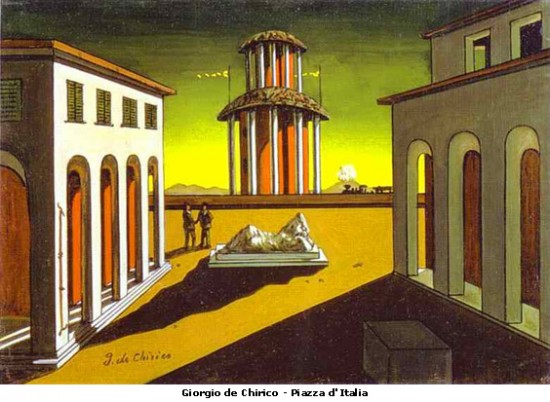
The photo above is of a typical de Chirico painting, whereas the one below is of Yeargan’s set model for the abduction scene at the conclusion of Act I.
It is easy to see the genesis of the opening tableau, and also of the final result in the production photo below.
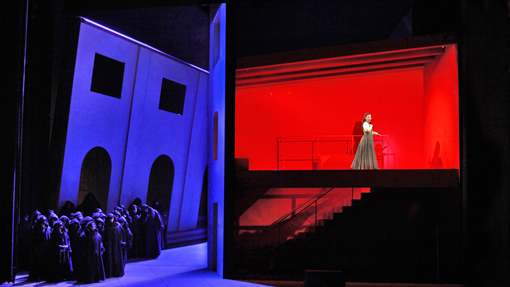
Note not only the slightly nightmarish shapes, but also the brilliant contrasting colors and intensity of the lighting. Another effective lighting technique was the occasional use of large shadows as shown below.
The story of Rigoletto is so familiar to me that it came as something of a shock to realize that the only other performance I had seen within the past dozen or so years was a European HD performance from Mantua, Italy starring Placido Domingo which I saw last year. Why should this opera remain so vividly in my memory while other operas such as La Vida Breve, Attila, Rodelinda, Capriccio, and Iphig?nie en Tauride, all of which I saw last year are half-remembered at best?
Perhaps because all of the elements of the opera are a mixture of simple and complex. Rigoletto is one of the most complex characters in all opera. Born a hunch-back, he is equally deformed mentally and morally. But there is one beautiful thing in his life – his teenage daughter Gilda. His love for her, flawed though it may be by jealousy, somehow differentiates him from other operatic villains such as Iago or Scarpia.
I don’t believe that anyone could ever capture that complex character as well as Placido Domingo did in the European HD performance filmed at Mantua, but I have no complaints with the creditable job done by Marco Vratogna.
Gilda goes through quite a transformation in the 16 hour elapsed time of the plot. Albina Shagimuratova is the essence of an innocent young girl in love as she sings Caro Nome in Act I and is an all-too-wise woman after being raped by the Duke in Act II. But she retreats into naivety in Act III when she accepts the fact that the Duke has forgotten her already but still “nobly” sacrifices her life to save his. Albina Shagimuratova handles all these changes with aplomb, both musically and in her acting.
The Duke, on the other hand is relatively simple. He is completely amoral. The rest of the world, particularly the women, exists solely for his pleasure. And Arturo Chac?n-Cruz’ fine tenor voice and acting clearly portrayed his irresistible charm on the outside and total self-centeredness on the inside.
These three major roles have been double-cast for the 12-performance run of Rigoletto. The singers I saw and heard on Friday night are named in the three paragraphs above. For the record, the other three principals (who performed at the opening night on Thursday) are Željko Lučić (Rigoletto), Aleksandra Kurzak (Gilda), and Francesco Demuro (The Duke of Mantua).
The supporting characters all sang in both casts. With the possible exception of Robert Pomakov’s Monterone – I’ve heard better curses – they were all very good, particularly Andrea Silvestrelli whose deep bass voice and towering figure were perfect for the professional assassin, Sparafucile.
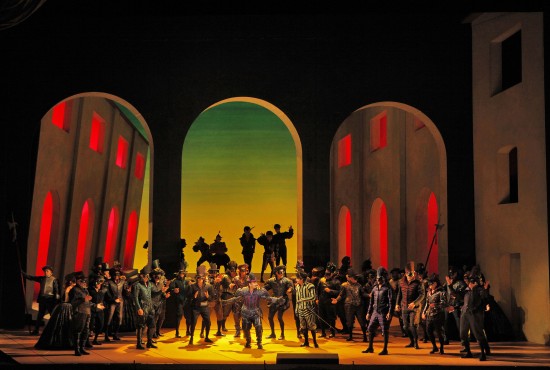
As usual, the Chorus and Dancers were excellent. And Maestro Nicola Luisotti did a superlative job of playing some of Verdi’s best music. Only two chances left to see it:
Tue 09/25/12 7:30pm “?and Sun 09/30/12 2:00pm.
For detailed information and to buy tickets go to San Francisco Fall 2012.
San Francisco Opera
301 Van Ness Avenue
San Francisco, CA 94102
(415) 861-4008
sfopera.com
Except as noted, all photos by Cory Weaver, San Francisco Opera
This review by Philip G Hodge appeared in sanfranciscosplash.com on September 23, 2012.

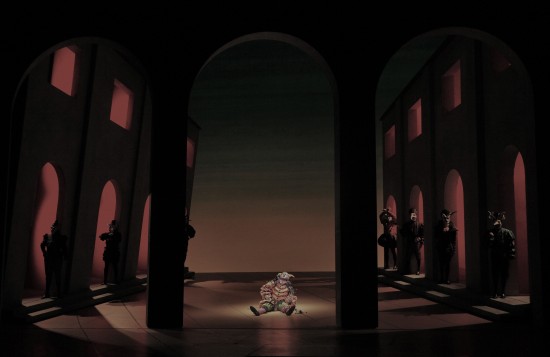

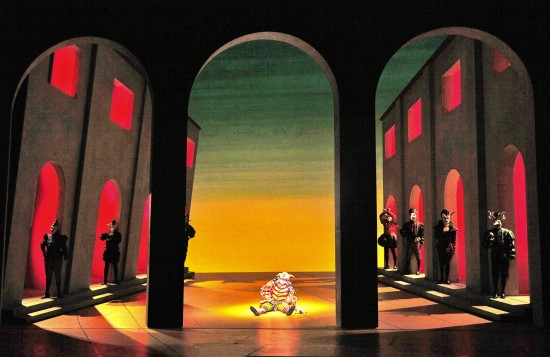
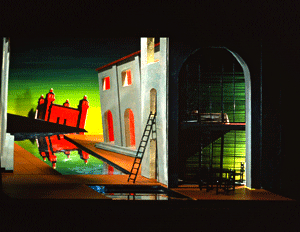

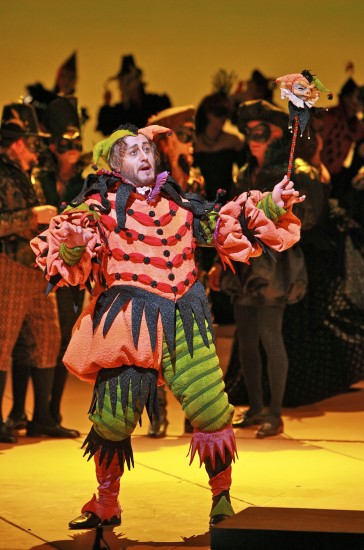
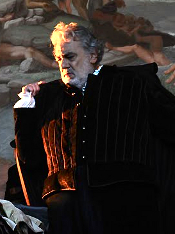


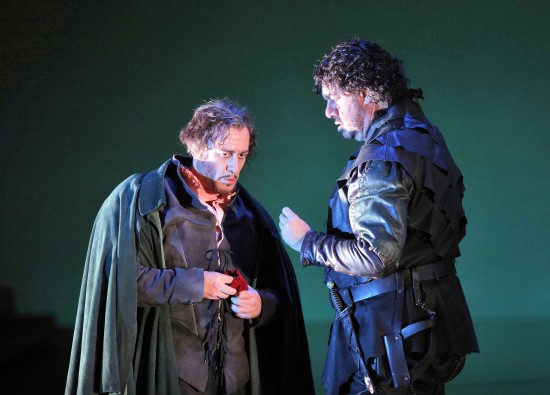

may i use the photograph with the shadow of Rigoletto for drawing attention to this masterpiece of Verdi? please advise. Kind regards Jack Spetter
I’m so glad you found this review from the past! We don’t have a problem with that, but perhaps you should ask permission from the San Francisco Opera (sfopera.com/press/)
Except as noted, all photos in this review were taken by Cory Weaver, San Francisco Opera. On SF Opera’s website they say, “These copyrighted images may only be used for editorial purposes promoting San Francisco Opera and must include photographer credits. … For press inquiries, please contact press@sfopera.com“